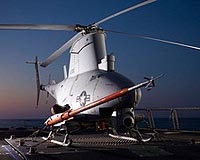| . |  |
. |
Eagan MN (SPX) May 11, 2009 Lockheed Martin has successfully completed flight testing of a new signals intelligence (SIGINT) payload and a next generation wing design that will provide enhanced capabilities for the company's small Desert Hawk III (DHIII) Unmanned Aircraft System (UAS). Lockheed Martin's current DHIII is an open architecture system that consists of three key components: a light-weight, hand-launched, rugged air vehicle with a number of snap-on payloads (Plug and PlayloadsTM); a portable ground station; and a remote video terminal. The air vehicle's quiet operation and 360-degree optical turret provides the war fighter with stealthy, autonomous intelligence, surveillance and reconnaissance (ISR) capabilities. The system also includes programmable terrain avoidance and dynamic flight re-tasking options for the operator. The British Army has used DHIII extensively in both Afghanistan and Iraq. The recent DHIII flight tests mark the first time a SIGINT payload has successfully flown onboard a small UAS platform. The new payload option will significantly expand the DHIII's surveillance capabilities by adding the ability to detect and locate sources of radio frequency emissions. The DHIII's new wing design improves the air vehicle's flight envelope and lift capacity for operations at higher altitudes, in high-wind conditions and in extreme temperature environments. The design change also reduces the minimum take-off and landing speed requirement for the warfighter, providing easier launches and recoveries in difficult terrain and environments. Flight testing of the new payload and wing design was conducted at the California National Guard's Camp Roberts and the Minnesota National Guard's Camp Ripley in April 2009. Lockheed Martin anticipates that these new enhancements to the DHIII will become operational capabilities later this year. "We are committed to providing new capabilities that vastly improve situational awareness and force protection," said John Nikolai, director of Electronic Products and Logistics at Lockheed Martin's Tactical Systems business. "We are proud of the flexibility that DHIII continues to demonstrate by enabling low-risk and rapid insertion of critical ISR capabilities." Share This Article With Planet Earth
Related Links Lockheed Martin UAV News - Suppliers and Technology
 MQ-8B Fire Scout Completes Second Test Period Onboard USS McInerney
MQ-8B Fire Scout Completes Second Test Period Onboard USS McInerneySan Diego CA (SPX) May 11, 2009 A Northrop Grumman-developed MQ-8B Fire Scout Vertical Takeoff and Landing Tactical Unmanned Aerial Vehicle (VTUAV) successfully completed fully autonomous flight operations onboard the USS McInerney (FFG-8) frigate. These operations marked the first time that the Navy operated an autonomous VTUAV aboard a surface combatant vessel. This follows at-sea operations aboard the USS Nashvi ... read more |
|
| The content herein, unless otherwise known to be public domain, are Copyright 1995-2009 - SpaceDaily. AFP and UPI Wire Stories are copyright Agence France-Presse and United Press International. ESA Portal Reports are copyright European Space Agency. All NASA sourced material is public domain. Additional copyrights may apply in whole or part to other bona fide parties. Advertising does not imply endorsement,agreement or approval of any opinions, statements or information provided by SpaceDaily on any Web page published or hosted by SpaceDaily. Privacy Statement |